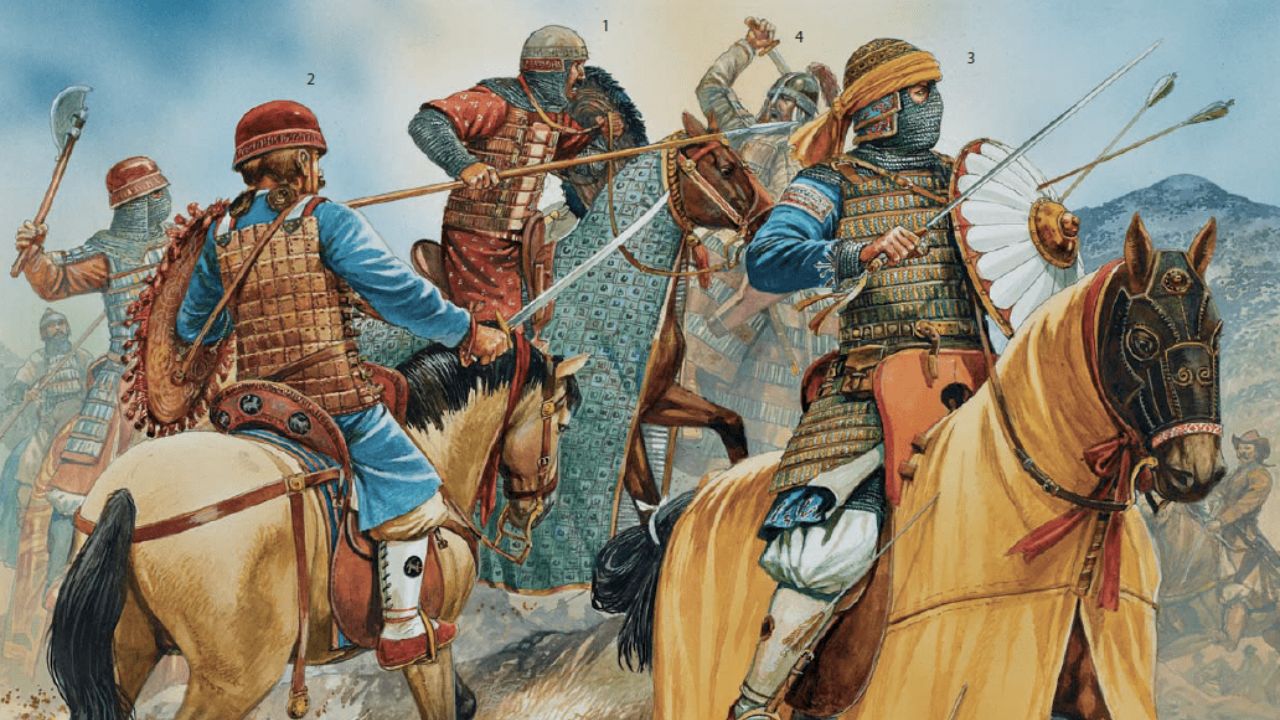In the 13th century AD, the Mongols launched a massive attack against the Islamic world and spread terror and mayhem. The Islamic Khalifah was assassinated, and three-fourths of the Muslim countries, including the capital Baghdad, fell under the Mongol rule.
In these testing times, a great leader emerged. He fought one of the decisive battles in the history of Islam and led the Muslim Ummah when it had lost its centrality. This leader was Saif ad-Din Qutuz and the battle he won is the historic battle of Ain Jalut. He was ably supported by his lieutenant Rukn al-Din Baibars, who played a heroic role in implementing the Mongols’ military strategies to themselves.
Mongol Aggression and Occupation
Mongols entered the Islamic lands at the end of 656 AH. As the Khalifah, Al-Musta’sim Billah, started to gather his armies to repel the invasion, his minister Ibn al-Alqami duped him into thinking that peace with the invaders was feasible, and any preparation of forces would preclude any chance of reconciliation. Al-Alqami, began a secret correspondence with the Mongols and promised the Mongols that there would be no resistance in the event of an invasion if they assured of making Al-Alqami the Khalifah if the invasion was successful. He deceived the Muslims and succeeded in convincing them that a peace treaty was about to be concluded with the Mongols. Al-Musta’sim set out with his ministers and other leaders to meet the leader of the Mongols. The Mongols killed everyone and violated the honour of the Muslims in a very base manner. Al-Alqami himself was declared a traitor and killed by the Mongols, putting an end to his dream of ascending the Khilafah.
Muslims had to contend with defeat after defeat when Baghdad fell. After taking over all of Iraq, the Mongols invaded Syria (which includes all of modern-day Syria, Jordan, Palestine, Lebanon, and some parts of Egypt) and increased oppression and persecution because the residents of these countries refused to submit to their rule.
After the fall of Damascus, the Mongols advanced towards Egypt and Morocco, the final Muslim strongholds, knowing that if they were conquered, there would be no resistance till they reached the Holy lands of Makkah and Madinah.
Mongol Challenge to Mamluks
The Mongol commander “Katabagha” sent a threatening letter to the Amir of Egypt. It read something like this: “We have laid siege to the land, orphaned the children, punished and killed the people, destroyed the honour of their leaders. Do you really think you can escape from us? You will eventually be able to see what is heading your way.”
The Muslims were greatly impacted by this letter. Sultan Qutuz, who had been raised according to Islamic principles, answered differently than the other ruler. He killed the Mongol delegation and hung their bodies in his capital, which boosted the morale of his forces and people.
When Qutuz’s reply arrived, the Mongols knew they were dealing with a different kind of King in Egypt than they had encountered before. Qutuz’s act drives inspiration from Muslim History and followed the example of Abbasid Khalifa Harun al-Rashid’s reply to the Roman chief “Nakfur” and “Al-Mu’tasim” to the governor “Amuria”.
Preparations for War
Qutuz anticipated the possible response to his unambiguous response. He thus began his preparations. Before arming his people with physical weapons, he armed them with faith and unity. He dispatched Baibars, his gallant and popular deputy, to the dispersed Muslim chieftains in an effort to bring about unity. Baibars was successful in bringing together a number of emirs to fight the Mongols, a common foe.
To bolster his military endeavours, Baibars commissioned battleships, freighters, and arsenals. He may have also been the first person to utilise explosive hand cannons in a battle (He was named Bunduqdari).
On the Other hand, Qutuz was also well aware of the importance of Islamic scholars and was also aware of their influence among the people. He appealed to the Ulama for help. Al-Azz bin Abdis Salam, known as the “Sultan Ulama,” was the most significant scholar to assist the Sultan. Qutuz asked Ibn Abdis Salam for a fatwa to levy more war taxes on the people so that more weapons could be obtained. The scholar, however, made it clear to the Sultan that the government could not impose any new tax on the people until the governor and ministers spent all their personal wealth and all their relatives. Al-Azz also ordered the sale of these slave chiefs who were important officials of the government but were not legally freed from their owners and had gained power in the army.
The required amount was met without imposing any new taxes on the people. The people who witnessed this whole effort with their own eyes became loyal to the Mamluk government.
Rukn al-Din Baibars practically held command of the forces. After listening to the stories of atrocities of the Mongols, Baibars used to say: “Let the time come, we will tell these barbarians that they are not the only ones who know how to fight, but there are also some people in the world who can snap their necks.”
After learning of Hulagu Khan’s return, Baibars promptly advised Sultan Qutuz to attack the Mongols; Qutuz then requested that he move forward. Baibars marched immediately and confronted the Mongol armies.
The Battle
Qutuz instructed his soldiers to advance and attack in accordance with the Prophet’s admonition that “those who resist an attack in the middle of their territory shall be dishonoured.”
The major forces of Qutuz, commanded by Qatzahi, moved in the direction of the Crusaders’ final strongholds, which were along the coast of Palestine. Here, Qutuz urged the Crusaders to remain neutral.
Qutz and Baybars selected the battleground themselves, in a valley surrounded by mountains, as the main Muslim forces drew near the hostile forces. In order to provide defence in the event of a treacherous Crusader attack or a Mongol or traitor attack from behind, the Mamluks stationed some warriors atop the highlands.
According to many historical sources, the Mamluk Army’s General command was led by Rukn al-Din Baibars who was later hailed as the main hero of the battle.
Mongols finally reached the battlefield, which was surrounded by three sides. The battle began and the balance seemed to tilt towards the Mongol forces. The right wing of the Mongol forces began to dominate the left wing of the Muslim forces. Muslim forces started retreating. In reality however, Baibars had used the Mongol against them. Baibars initially retreated and the Mongols fell into his trap. Entrapping the enemy by ambushing and trapping the enemy in a narrow place was the style of war of the Mongols, which was used by Baibars that day, and Kutabgha Khan, who was intoxicated by the past victories, fell into the trick of Baibars. A safe Egyptian army ambushed the Mongols in the gorge. Disruption spread in the Mongol army and they were attacked by Muslims from two sides.
Despite this, the Mongols continued to advance. To raise the spirits of his troops, Qutuz climbed a rock, took off his helmet, and yelled “Wa Islama wa Islama,” urging them to carry on fighting and urging the Muslim army not to flee from the battlefield. The demoralised chiefs of the Muslim forces looked at their leader Qutuz who was wielding his sword and madly penetrating between the ranks of the enemy. The Muslim forces’ morale was revived as a result of Qutuz’s bravery, which astounded the Muslim force’s leaders. The odds quickly shifted in favour of the Muslim soldiers.
The Mongol army was beaten and decimated by Baibars in a way that had never been done to the Mongols before. Kutabgha Khan was captured by Baibars and killed. The entire Mongol army was slain or taken prisoner. The body of Kutabgha Khan was exhibited in the streets of Cairo along with the other Mongol prisoners.
The news of the defeat of the Mongols at Ain Jalut spread like wildfire in Syria and Palestine. Muslims revolted against the Mongol rule and news started coming from everywhere that the Muslims had begun to retake their cities from the invaders. In this way, most of the occupied territories of Syria and Palestine were freed from the tyranny of the Mongols.
Impact of the War
In this manner, Rukn al-Din Baibars put a stop to the black tempest that had been draining the blood of the Muslim Ummah for forty years at the decisive battle of Ain Jalut. Although the Mongols continued to attack Muslims lands, but the impression of their invincibility was lost and now the Muslims were fighting them everywhere. The continuous Mongol attacks on India and the successful defense of the Khiljis is an example of it.
It was by the grace of Allah, that Egypt had leaders who rose up at the right time and had the courage to stand up to the Mongols and defend Egypt and Syria from the wrath of the Mongols. Otherwise, these countries would have suffered the same fate as Iran, Iraq and Turkestan.
The death of Mongke Khan, the Mongol king, the subsequent withdrawal of Hulagu Khan and his inability to return to the Islamic world due to the Mongol Civil War, and Berke Khan’s conversion to Islam just before the war with Egypt are indications that not only the Mamluks and Mongols but also divine intervention played the biggest role in this battle. Egypt was the last significant fortress on the Holy Land of Hejaz. It wouldn’t be incorrect to claim that Allah safeguarded Haramain Sharifain, Bayt al-Maqdis, etc. with his soldeirs this time around instead of sending ababils from the skies.
The clash of the Mamluk and Mongol forces at Ain Jalut is one of the most important battles in world history—comparable to the battles of Marathon, Salams, Lapanto, Colonus, and Tugh—because it decided the fate of both the Islamic and Western civilization. After Hulagu return, the Mongols would have surely gone as far as the Straits of Gibraltar in East Africa if they had been successful in capturing Egypt. Under these circumstances, would the Renaissance have occurred in Europe? If it had, its foundations would undoubtedly have been much weaker and the world would probably be a much different place today.
The liberation of the Muslim Ummah and Muslim lands from the tyranny of the Mongols was a direct outcome of this battle. As a result, the morale of the Muslims was raised, and the correct teachings of Islam was disseminated among them, saving them from complacency, complacency, and defeat.
Related






































